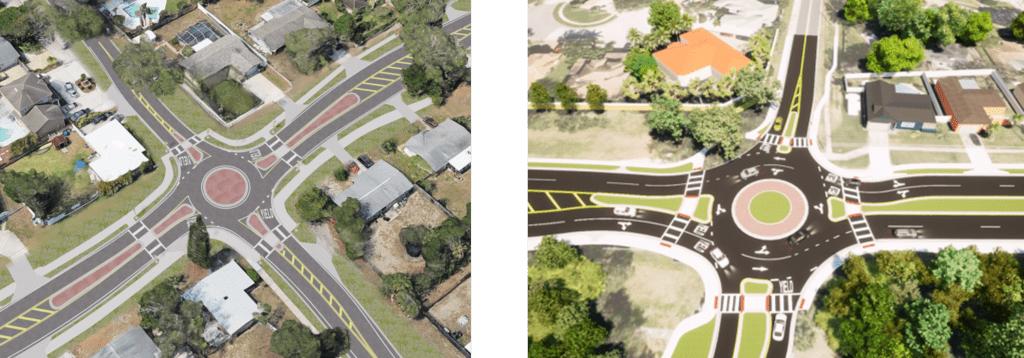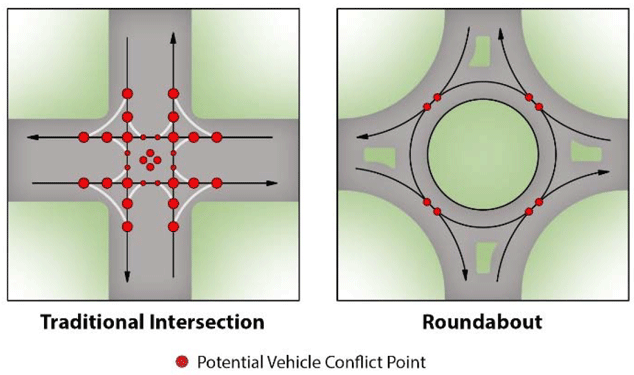Roundabouts and Innovative Intersections
Improving intersection safety is a high priority for Pinellas County. Crashes at intersections represent about 25% of all traffic fatalities and half of all severe crashes, according to the Federal Highway Administration. Roundabouts and other innovative intersections are being explored as promising solutions for their ability to reduce the total number of accidents, and their severity, while improving traffic flow.
Why Roundabouts?
Roundabouts are designed to make intersections safer and more efficient for drivers, pedestrians and cyclists. There are two basic types of roundabouts: single-lane and multi-lane.
Modern roundabouts are designed to accommodate vehicles of all sizes, including all emergency vehicles, buses, and semi-truck and trailer combinations. The central island of the roundabout is designed to allow the back wheels of large vehicles to ride up on the island to complete the turn. In addition to the central island, roundabouts feature splitter islands designed to slow and direct traffic approaching the intersection. The splitter islands also provide a safe place for pedestrians to cross traffic.

How to Safely Navigate a Roundabout
Roundabouts Improve Safety and Traffic Flow
The circular shape of a roundabout is designed to reduce speeds to less than 25 mph while minimizing conflict points. A conflict point is a location where multiple vehicle travel paths intersect. A typical 4-way-stop intersection has 32 possible vehicle conflict points and 24 pedestrian conflict points, while a roundabout has only 8 vehicular conflict points and 8 pedestrian conflict points.

Lowering speeds and reducing conflicts substantially reduces the number of crashes that result in injuries or fatalities. Lower speeds and the reduced need to come to a complete stop also helps keep road noise levels down for surrounding homes and businesses.
The few collisions that occur in roundabouts are typically minor and cause few injuries. Roundabouts are not only a safer type of intersection; they are also more efficient in terms of keeping people moving. Even while calming traffic, they reduce delay and queuing compared to stop signs or signals.
Roundabout Traffic Analysis
Roundabout Safety
According to studies from the Insurance Institute of Highway Safety (IIHS) and Federal Highway Administration (FHWA), the most severe types of vehicle-on-vehicle crashes, such as T-bone, left-turn, and head-on collisions are avoided with a roundabout. Roundabouts also provide:
- 90% reduction in fatal crashes
- 75% reduction in injury crashes
- 40% reduction in pedestrian crashes
- 37% reduction in overall collisions
Roundabout Efficiency
- Roundabouts increase traffic capacity by 30-50% compared to traditional intersections (FDOT).
- Roundabouts in place of traffic signals or stop signs has been found to reduce carbon monoxide emissions by 15%-45%, nitrous oxide emissions by 21%-44%, carbon dioxide emissions by 23%-34% and hydrocarbon emissions by up to 40% (IIHS).
- Roundabouts in place of traffic signals or stop signs reduced fuel consumption by an estimated 23%-34% (IIHS).
- Roundabouts require less maintenance, have lower yearly operational costs and have a longer service life than a signalized intersection.
- Because roundabouts can handle greater volumes of traffic more efficiently than traffic signals, roundabouts require fewer overall lanes approaching the intersection, compared to traffic signals.
- Roundabouts function efficiently during both peak hours and off times.
- Roundabouts do not require a power source, so they continue to function during power outages and natural disasters.
Roundabouts in Pinellas County
- Alternate 19 and Florida Avenue in Palm Harbor (FDOT)
- Pinellas Bayway/Madonna Boulevard/1st Street E. in Tierra Verde (FDOT)
- Indian Rocks Road and Ponce De Leon Boulevard in Belleair (Town of Belleair)
- Mandalay Avenue and Acacia Street in Clearwater (City of Clearwater)
- Palmetto Street and Casler Avenue in Clearwater (City of Clearwater)
- Rainbow Drive and Comet Avenue in Clearwater (City of Clearwater)
- Cleveland Street and Aurora Avenue in Clearwater (City of Clearwater)
- Harn Boulevard and S. Clairborne Drive in Clearwater (City of Clearwater)
- Harn Boulevard and Stewart Boulevard in Clearwater (City of Clearwater)
- Fairwood Avenue and Park Trail Lane in Clearwater (City of Clearwater)
- Fairmont Street and Fulton Avenue in Clearwater (City of Clearwater)
- Richards Avenue/Baker Avenue/Casler Avenue in Clearwater (City of Clearwater)
- Palmetto Street and N. MLK Jr. Avenue in Clearwater (City of Clearwater)
- Cleveland Street and Saturn Avenue in Clearwater (City of Clearwater)
- Cleveland Street and Lake Drive in Clearwater (City of Clearwater)
- Cleveland Street and Corona Avenue in Clearwater (City of Clearwater)
- SR 60/Coronado Drive/Mandalay Avenue/Poinsettia Avenue in Clearwater (City of Clearwater)
- 38th Avenue S. and 37th Street S. in St. Petersburg (City of St. Petersburg)
- 49th Street N. and 24th Avenue N. in St. Petersburg (City of St. Petersburg)
- Villa Grande Avenue and Park Street S. in South Pasadena (City of South Pasadena)
- Skinner Boulevard and Douglas Avenue in Dunedin (FDOT)
- Skinner Boulevard and Highland Avenue in Dunedin (FDOT)
- Bayview Boulevard and St. Petersburg Drive in Oldsmar (City of Oldsmar)
Other Innovative Intersections
County engineers are exploring the benefits of bringing proven innovative intersection designs, already in-use across the United States, to help improve safety and reduce congestion. The following innovative intersections have proven successful in other communities and may someday be used on Pinellas County roads.
Displaced Left Turn
A Displaced Left Turn (DLT) is a type of intersection in which all left turns from the main road and in some cases left-turns from side streets are made in a two-stage process. Vehicles first cross from the center to the opposite side of the roadway at an upstream secondary signalized intersection, and then proceed to the primary signal via a special roadway parallel to the main road. At the primary signal, vehicles complete the left turn at the same time as through traffic because they are no longer in conflict with one another, due to the upstream crossover intersections.
DLT intersections are proven to reduce delay at high-volume locations by allowing left turning traffic and through traffic to proceed through the main intersection simultaneously. This eliminates the additional time necessary to accommodate left turns at a traditional intersection. The DLT provides reduced delay and improved operation at high volume intersections, for a greatly reduced cost and physical footprint when compared with a grade-separated interchange.
DLT Benefits
- Free-flow in one direction: One direction of travel on the major street never stops, which improves traffic signal synchronization and reduces corridor travel times.
- Improved safety: Channelizing left-turn vehicles from the side street reduces the potential for angle crashes.
- Increased efficiency: One direction of travel on the major street is free-flow, and, as a result, more green time can be provided to the other movements, reducing delay.
Median U-Turn
The Median U-Turn (MUT) intersection improves safety and efficiency by changing how left turns are handled. Instead of making a left turn at the main intersection, vehicles proceed through, make a U-turn a short distance downstream, and finally turn right back at the main intersection.
At an MUT intersection, side-street motorists may proceed straight through the intersection or turn right onto the main road. Main road motorists will be directed to proceed to the legal U-turn to reach the side-street.
An MUT is a good choice for intersections with heavy through traffic and moderate left-turn volumes. Studies have shown a 20%-50% improvement in intersection throughput for various lane configurations as a result of implementing the MUT design (FHWA). When implemented at multiple intersections along a corridor, the efficient two-phase signal operation of the MUT can reduce delay, improve travel times, and create more crossing opportunities for pedestrians and bicyclists.
MUT Benefits
- Improved safety: Reduces the number of points where vehicles cross paths and decreases the potential for right-angle crashes.
- Increased efficiency: Eliminates left-turn movements from the main intersection, allowing for fewer traffic signal phases, which reduces delay and increases capacity.
- Shorter wait times: Fewer traffic signal phases means less time stopped at the main intersection.
- Cost and space effective: A MUT is more cost and space-effective than adding lanes to increase capacity.
Restricted Crossing U-Turn
The Restricted Crossing U-Turn (RCUT) improves safety and operations by changing how side-street traffic crosses or turns left at a major road. An RCUT is most recognizable by its lack of left turn and straight through movements for side streets.
An RCUT requires vehicles on side streets to turn right on the main road and then make a U-turn. Drivers on the main road are able to make left and right turns or proceed straight through like a typical intersection.
RCUT Benefits
A Restricted Crossing U-Turn intersection reduces the number and type of conflict points and simplifies a driver’s decision-making. In this design, a driver focuses on one direction of traffic at a time. Crossing conflicts are reduced from twenty-four to four which has been shown to significantly reduce right-angle crashes.
- Reduces crash potential – particularly far side right angle crashes.
- Simplifies driving task – only required to look at one direction of traffic at a time.
- Provides additional space for longer vehicles to store in the median.
- Easily retrofitted – often without purchasing additional right-of-way.
- Low cost compared to an interchange or overpass while continuing to provide access.
- Studies have shown that installing an RCUT can result in a 30% increase in throughput and a 40% reduction in network intersection travel time (FHWA).